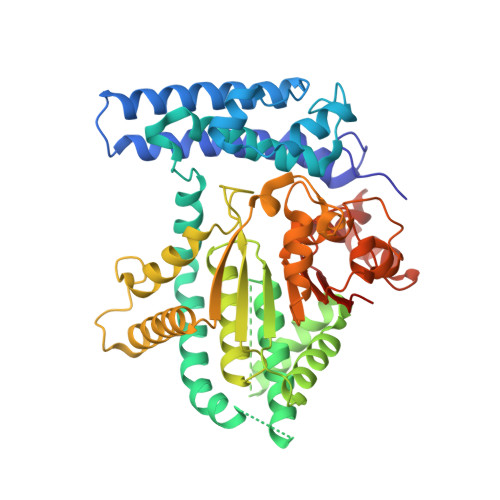A family of metal-dependent phosphatases implicated in metabolite damage-control.
Huang, L., Khusnutdinova, A., Nocek, B., Brown, G., Xu, X., Cui, H., Petit, P., Flick, R., Zallot, R., Balmant, K., Ziemak, M.J., Shanklin, J., de Crecy-Lagard, V., Fiehn, O., Gregory, J.F., Joachimiak, A., Savchenko, A., Yakunin, A.F., Hanson, A.D.(2016) Nat Chem Biol 12: 621-627
- PubMed: 27322068
- DOI: https://doi.org/10.1038/nchembio.2108
- Primary Citation of Related Structures:
5F13 - PubMed Abstract:
DUF89 family proteins occur widely in both prokaryotes and eukaryotes, but their functions are unknown. Here we define three DUF89 subfamilies (I, II, and III), with subfamily II being split into stand-alone proteins and proteins fused to pantothenate kinase (PanK). We demonstrated that DUF89 proteins have metal-dependent phosphatase activity against reactive phosphoesters or their damaged forms, notably sugar phosphates (subfamilies II and III), phosphopantetheine and its S-sulfonate or sulfonate (subfamily II-PanK fusions), and nucleotides (subfamily I). Genetic and comparative genomic data strongly associated DUF89 genes with phosphoester metabolism. The crystal structure of the yeast (Saccharomyces cerevisiae) subfamily III protein YMR027W revealed a novel phosphatase active site with fructose 6-phosphate and Mg(2+) bound near conserved signature residues Asp254 and Asn255 that are critical for activity. These findings indicate that DUF89 proteins are previously unrecognized hydrolases whose characteristic in vivo function is to limit potentially harmful buildups of normal or damaged phosphometabolites.
Organizational Affiliation:
Food Science and Human Nutrition Department, University of Florida, Gainesville, Florida, USA.


















